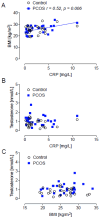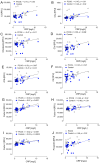Association of Complement Proteins with C Reactive Protein in Non-Obese Women with and Without Polycystic Ovary Syndrome
- PMID: 40243681
- PMCID: PMC11989124
- DOI: 10.3390/ijms26073008
Association of Complement Proteins with C Reactive Protein in Non-Obese Women with and Without Polycystic Ovary Syndrome
Abstract
Complement proteins are increased in polycystic ovary syndrome (PCOS), as are markers of inflammation, such as the C-reactive protein (CRP); however, both may be increased in obesity. We hypothesised that body mass index (BMI)-driven CRP would comparably associate with an increase in complement proteins when obesity was accounted for in non-obese women with and without PCOS. In a non-obese, non-insulin-resistant population without inflammation (24 with PCOS and 24 control women), plasma CRP was measured by immunoassay. Slow Off-rate Modified Aptamer (SOMA)-scan plasma proteomic analysis of the classical, lectin, and alternative pathway complement proteins was undertaken. BMI, insulin resistance, and CRP did not differ (p < 0.05) between the cohorts. The alternative pathway of the complement protein system was overexpressed in PCOS (p < 0.05). CRP correlated positively (p < 0.05) with alternate pathway parameters in women with and without PCOS for C3a, iC3b, Factor B, Factor H, and Factor I; in PCOS alone for C3, C3adesArg, and C3d; and in women without PCOS, for properdin. CRP did not correlate with lectin pathway C2 or MBL (p > 0.05). CRP correlated positively (p < 0.05) with C4 of the classical pathways in women with PCOS alone. Hyperandrogenemia did not correlate with CRP or complement in non-obese PCOS. BMI correlated positively with C3, C3adesArg, C3a, iC3b, Factor B, Factor H, and properdin: classical pathway proteins; C1q, C4, C5 and C5a in PCOS women; BMI only correlated negatively with C1q in non-PCOS women. Upregulation of complement proteins occur in non-obese PCOS, and CRP is positively associated with complement protein changes in both women with and without PCOS. This indicates that BMI induces changes in CRP that lead to changes in the complement pathways, particularly the alternate pathway, with increases in CRP (though still within the reference laboratory normal range) leading to upregulation of complement proteins in PCOS. This suggests an enhanced set point for CRP-induced complement protein dysregulation in PCOS.
Keywords: BMI; C-reactive protein (CRP); complement factors; inflammation; polycystic ovary syndrome.
Conflict of interest statement
The authors declare no conflicts of interest.
Figures



References
-
- Sathyapalan T., Shepherd J., Coady A.M., Kilpatrick E.S., Atkin S.L. Atorvastatin reduces malondialdehyde concentrations in patients with polycystic ovary syndrome. J. Clin. Endocrinol. Metab. 2012;97:3951–3955. - PubMed
-
- Bannigida D.M., Nayak B.S., Vijayaraghavan R. Insulin resistance and oxidative marker in women with PCOS. Arch. Physiol. Biochem. 2020;126:183–186. - PubMed
MeSH terms
Substances
LinkOut - more resources
Full Text Sources
Medical
Research Materials
Miscellaneous

